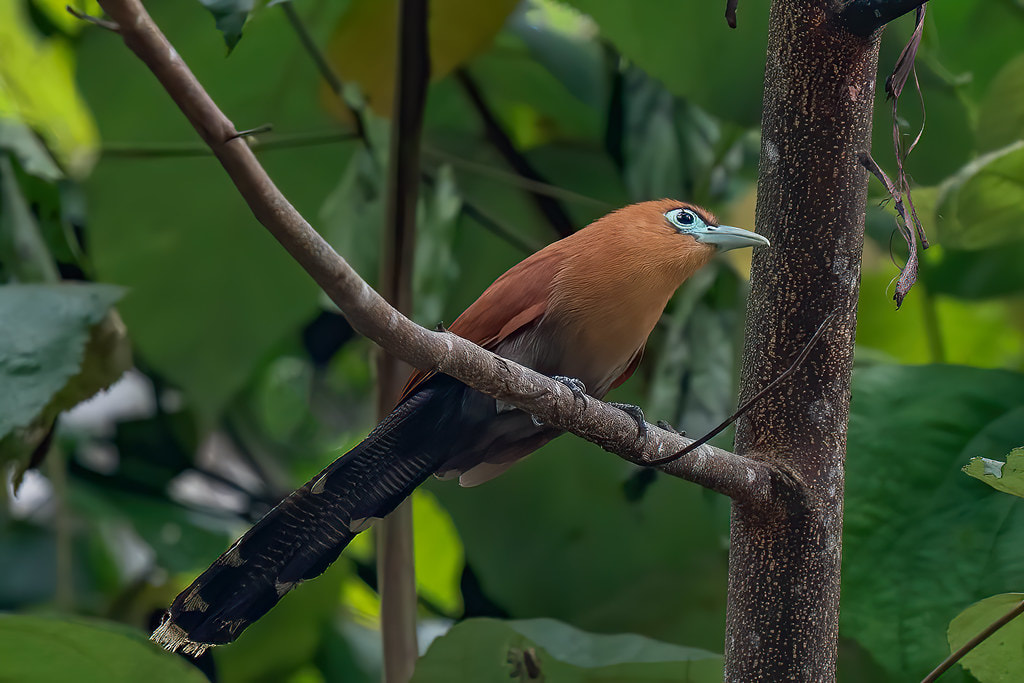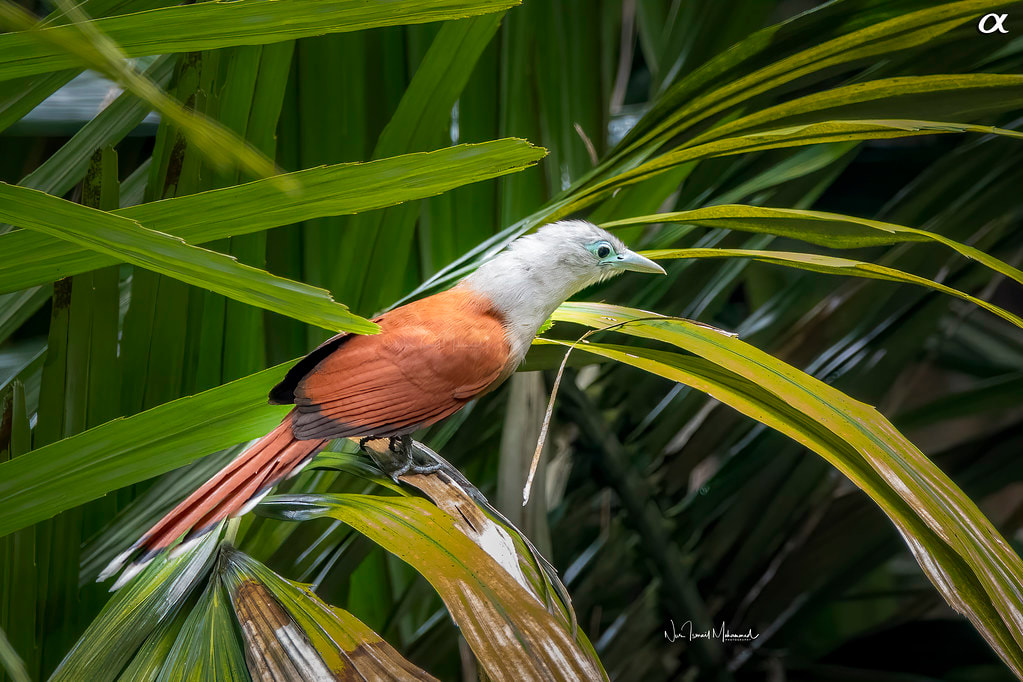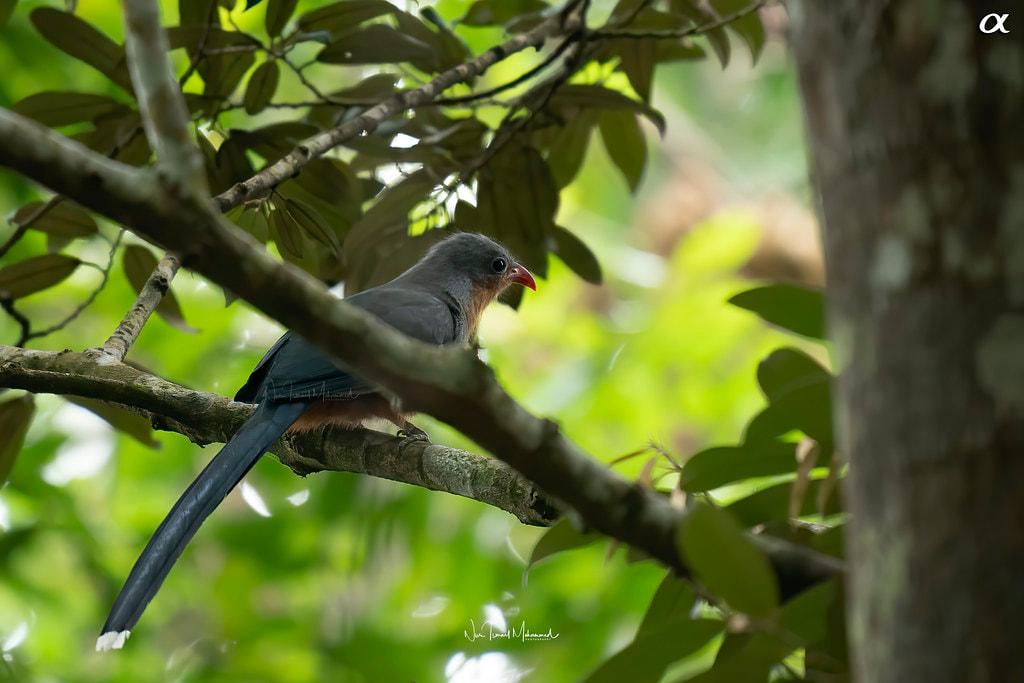|
I am really glad to have photographed all the malkohas of Malaysia, during the span of two years of birding. The list of the malkohas is as follows:
Commonly known Raffle’s Malkoha or cenok kera in Malay (Jamaludin et al., 2007), this bird is the smallest malkoha among the five species recorded in Peninsular Malaysia with measurement around 33 cm in length (Strange & Jeyarajasingam, 1993). The males have chestnut brown crown, nape and mantle as well as lighter chestnut at the underparts of its body. In contrast the male appearance, the female species have grey crown and nape including the sides of the head, throat and breast. The underparts are light buff with chestnut brown mantle. Both sexes have bluish orbital skin and green bill. This species is endemic to Sundaland including Peninsular Malaysia and commonly inhabits the primary and secondary lowland rainforest. Raffle’s Malkoha is frequently resides on the forest canopy but will sometimes descend to the middle storey. [Source: MyBIS]. Name: Raffles's malkoha (male & female) Scientific: Rhinortha chlorophaea Malay: Cenuk Kecil / Cenuk Kerak Family: Cuculidae IUCN Red List (v3.1, 2016): Least Concern Gear: SONY a9 + SEL200600G. Location: Lanchang, Pahang The black-bellied malkoha is a species of malkoha in the family Cuculidae. It is found in Brunei, Indonesia, Malaysia, Myanmar, Singapore, and Thailand. Its natural habitats are subtropical or tropical moist lowland forests and subtropical or tropical mangrove forests. It is threatened by habitat loss. [Source: MyBIS]. Name: Black-bellied malkoha Scientific: Phaenicophaeus diardi Malay: Cenok Perut Hitam Family: Cuculidae IUCN Red List (v3.1, 2016): Near Threatened Gear: a9II + SEL200600G + SEL14TC. Location: Ampang, Selangor. The green-billed malkoha is a species of non-parasitic cuckoo found throughout Indian Subcontinent and Southeast Asia. The birds are waxy bluish black with a long graduated tail with white tips to the tail feathers. The bill is prominent and curved. These birds are found in dry scrub and thin forests. Green-billed malkoha is about 50–60 cm centimetres long and weighs 100–128 g. It often has a clear white boarder to the red face patch salty grey on the face and neck. Adult green-billed malkoha has dark grey with green gloss above, oily green wings. Its breeding habitat is Primary forest, second growth, dense thickets, scrub, cultivated areas, rubber plantations across south Asia east from Nepal, India, and Sri Lanka to the Southeast Asia. [Source: MyBIS]. Name: Green-billed malkoha Scientific: Phaenicophaeus tristis Malay: Burung Kera / Cenok Kera / Cenok Besar / Cenok Paruh Hijau / Sewah Kera Family: Cuculidae IUCN Red List (v3.1, 2016): Least Concern Gear: a9II + SEL200600G + SEL14TC. Location: Ampang, Selangor. Zanclostomus javanicus is a type of cuckoo in the family Cuculidae. It is known as the red-billed malkoha in English or cenok api in Malay. Red-billed malkoha is a large-sized bird as it can grow up to 45 cm in length. It can be identified by its diagnostic red bill, blue orbital skin, pale cinnamon throat and upper breast merging into its rufescent grey belly. Its undertail is greyish with a slight gloss. This species can be found from Myanmar south to Malaysia and Brunei. In Malaysia, red-billed malkoha is a fairly common species. It is found in primary and mature secondary rainforest from low elevations up to 1200 m. It is quite difficult to see this species as they rarely cross open spaces. [Source: MyBIS]. Name: Red-billed malkoha Scientific: Zanclostomus javanicus Malay: Cenuk Api / Cenuk Paruh Merah Family: Cuculidae IUCN Red List (v.3.1, 2016): Least concern Gear: SONY a9II + SEL200600G. Location: Bukit Tampin Measuring about 46-50 cm in length (Strange & Jeyarajasingam, 1993), Chestnut-breasted Malkoha (Phaenicophaeus curvirostris) has a dark glossy green upperpart including ¾ base of its tail. Their underparts and ¼ of the remaining tail are chestnut brown (Strange & Jeyarajasingam, 1993). It also has bright red orbital skin and a large bill with big green upper mandible and red lower mandible. Chestnut- breasted malkoha is endemic to Sundaland and commonly inhabits the lowland rainforest. It resides on the middle storey of the forest. Among the five species of Malkohas found in Peninsular Malaysia, the Chestnut- breasted Malkohas is the only species which do not have white barrings on the underside of its tail (Strange & Jeyarajasingam, 1993). [Source: MyBIS]. Name: Chestnut-breasted malkoha (male & female) Scientific: Phaenicophaeus curvirostris Malay: Cenok Birah / Cenok Dada Coklat / Cenok Dada Perang Family: Cuculidae IUCN Red List (v3.1, 2016): Least Concern Gear: SONY a9II + SEL600F40GM + SEL14TC. Location: Hulu Langat, Selangor. The Chestnut-bellied Malkoha is an arboreal bird from cuckoo family which mostly loves on the canopy or middle storey trees. In Peninsular Malaysia, this species can be found in lowland rainforest and mangroves. The nests are made of pile of small sticks and usually placed high up in a tree (Strange & Jeyarajasingam, 1993).
This bird has dark glossy green mantle plumage with grey crown, throat and breast. It can be easily identified by its long tails, bright green bill, red orbital skin and chestnut shade on its belly. Name: Chestnut-bellied malkoha Scientific: Phaenicophaeus sumatranus Malay: Cenok Kecil / Cenuk Kecil / Cenuk Perut Coklat Family: Cuculidae IUCN Red List (v3.1, 2016): Near Threatened Gear: SONY a9 + SEL200600G + SEL14TC. Location: Kuala Selangor, Selangor.
0 Comments
Your comment will be posted after it is approved.
Leave a Reply. |
AuthorThis is the photography journey of Nur Ismail Photography where all the experiences from this year onwards will be shared with the audience. In collaboration with NiSi Malaysia, Leofoto, SONY Malaysia and Skylum Software. Thanks for viewing! Archives
August 2022
Categories |












